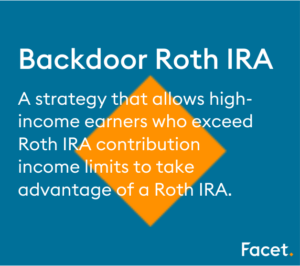
Key takeaways
- A Roth IRA offers tax-free investment growth and tax-free income but high income individuals aren’t eligible due to income limits
- A backdoor Roth IRA allows high income individuals to get money into a Roth IRA even if they make too much money for a direct contribution
- A backdoor Roth IRA requires contributing to a traditional IRA with after-tax money and then converting it to a Roth
- Making the most of the strategy and avoiding common mistakes requires a careful understanding of the process and tax reporting requirements
- A backdoor Roth IRA isn’t right for everyone and you should consider your broader financial plan and current tax law before moving forward
Roth IRAs are retirement savings accounts that offer tax-free growth and tax-free withdrawals (if you follow IRS guidelines).
The allure of tax-free income has made the Roth a popular savings vehicle for people early in their careers. The reason is because their income and tax rates are low relative to what they will be in the future. They have also grown in popularity for high-income earners.
The challenge that high earners face is that the IRS won’t let them contribute to a Roth if their income is too high.
So what do you do if you make too much to contribute to a Roth? A backdoor Roth IRA.
How a regular Roth IRA works
With a Roth IRA, you contribute after-tax dollars as opposed to before-tax dollars like you would contribute to a traditional IRA or 401(k).
You elect to pay taxes today so you don’t have to pay them in the future.
Once your money is in the Roth IRA, you can invest it however you choose.
Those investments grow free from taxes and, assuming you meet all withdrawal requirements, your withdrawals are tax free as well.
How much you can contribute to a Roth IRA depends on your income.
Roth IRA 2023 income limits
- If you file taxes as single, your Modified Adjusted Gross Income (MAGI) must be under $153,000.
- If you're married and file jointly, your MAGI must be under $228,000.
- If you’re married and file separately, your MAGI must be under $10,000.
- There are phase-outs, or income ranges, that may make you eligible for a partial contribution if your income is close to, but not higher than, these income limits.
If your income makes you ineligible for a direct Roth IRA contribution, you may need to consider a backdoor Roth IRA strategy.
Here’s what a backdoor Roth IRA is, how the process of a Roth IRA conversion works, and what you need to know to determine if this strategy is right for you.
What is a backdoor Roth IRA?
A backdoor Roth is not an official type of retirement account. It’s a Roth IRA that is funded via a “backdoor” strategy. It allows high-income individuals and households to fund a Roth despite exceeding the IRS income limits stated above.
Instead of making a direct Roth contribution, you put money into a traditional IRA and then convert, or exchange, the money from the IRA to the Roth IRA.

Why is it called a backdoor Roth IRA?
Think of the direct Roth contribution as the front door of a house. If that door is locked (i.e., you can’t make a direct contribution), you can walk around the back of the house and enter through the back door (i.e., make a traditional IRA contribution and convert it to a Roth).
You still get into the house; just through the back door.
The process for setting up funding a backdoor Roth IRA, and the tax reporting requirements that come with it, can be tricky.
Here is a high level overview of how it works.
How a backdoor Roth IRA works
The process
If you exceed the IRS income limits that allow you to make a direct Roth IRA contribution, you will need to follow the process for making a backdoor contribution.
The process only requires a few steps, but you also need to understand how to report it on your tax returns.
1. Contribute to a traditional IRA
You start with making a contribution to a traditional IRA.
2. Convert it into a Roth IRA
Once the money is in the account, you then convert your IRA to an existing or new Roth IRA. The trick is that unlike regular, tax-advantaged IRA contributions, you do not claim a deduction on your tax return.
You may also hear this called a non-deductible IRA contribution.
This process works because there are no IRS-imposed income limits (like there are with Roth IRAs) on making non-deductible (or after-tax) contributions to an IRA.
The conversion to the Roth IRA is not taxable as long as there are no earnings on the amount you contributed and if you have no before-tax money already in the IRA.
3. Follow the rules to stay compliant
Once the money is in the Roth IRA, you receive the same tax-free growth and withdrawal benefits as direct Roth contributions as long as you meet the IRS rules for qualifying distributions.
You are still subject to regular Roth IRA 5-year rules that will affect how your converted funds and any earnings or growth are taxed or penalized, if at all, upon withdrawal.
When using this strategy, there are a few rules you need to know to get the process right and to avoid any tax related issues with the IRS.
Conversion rules and limitations
There are limits to how much you can contribute when utilizing the backdoor Roth IRA strategy.
- As with traditional and Roth IRA contributions, the maximum amount you can contribute per year in 2023 is $6,500 if age 50 and under, or $7,500 per year if age 50 or older.
- The year in which you turn 50 is the year in which you become eligible for the higher contribution limit, called catch-up contributions.
- Similar to IRA and Roth IRA contributions, you can make a non-deductible IRA contribution for the prior year all the way up to your tax filing deadline which is typically April 15th.
- This essentially allows you to backdate your contribution. If you file an extension for your tax returns, you must still make the IRA contribution by the first filing deadline.
- Keep in mind that the conversion from your IRA to your Roth IRA must be included on your tax return for the year in which the actual conversion is finalized, which isn’t always the same year for which you claim the non-deductible IRA contribution.
- So if you make an IRA contribution in March of 2024 and convert it immediately to a Roth IRA, you can report the IRA contribution on your 2023 tax return but will report the conversion on your 2024 tax return.
- There is no limit on how much you can convert from an IRA to a Roth IRA in a given year although, for planning reasons, you want to have a strategy to avoid adverse tax consequences if you have existing before-tax money in your IRA.
To make sure you get the process right, here’s a step-by-step guide for your backdoor Roth IRA.
How to set up backdoor Roth IRA
The backdoor Roth IRA process includes a few steps you need to know to get the contribution, conversion, and tax reporting correct. Here’s the breakdown:
-
Set up a traditional IRA (if you don’t already have one). You first need to establish a traditional IRA with a brokerage firm or financial institution (often called a custodian because they hold your investments). If you already have an IRA, you can use your existing account.
-
Put money into (contribute to) the traditional IRA. Next, you need to make your annual contribution. Per the limits above, the maximum you can contribute is either $6,500 or $7,500 depending on your age. You can do this once per year or on a monthly basis as long as you don’t exceed your annual limit.
-
Set up a Roth IRA (if you don’t already have one). Since you are converting to a Roth IRA, you need to establish the account to receive the funds from the IRA. Many brokerage firms, custodians, or financial advisors will automatically provide paperwork as part of the process. If you already have a Roth IRA, you can convert to your existing account.
-
Convert some or all of your IRA balance to a Roth IRA. To complete the conversion, you need to convert the money in your IRA to your Roth IRA. You can convert the entire account balance or any amount that makes sense. This all depends on the amount of pre-tax money you have in the account, if any, and your personal tax situation.
-
Report the contribution and conversion on your tax return. The primary form for both activities is Form 8606. You need to report the non-deductible contribution because this is how you and the IRS will track the amount of after-tax money you have in your IRA. For the year in which the conversion to the Roth IRA is completed, you will report the full amount on your tax return.
Getting the backdoor Roth IRA conversion and tax reporting process right is critical to taking advantage of the strategy and avoiding headaches down the road. Here are some of the mistakes you should avoid.
Backdoor Roth IRA tax mistakes to avoid
There are a few big mistakes that people make when executing this strategy:
- Incorrectly reporting the contribution: If you don’t report the non-deductible contribution on your tax return, the IRS will think all amounts converted from your IRA to your Roth IRA are fully taxable meaning you could end up paying taxes twice if you don’t catch it.
- Incorrectly reporting the conversion: Reporting the conversion for the wrong year or not reporting it at all can lead to amended tax returns and even issues with the IRS when they catch it.
- Not converting to a Roth IRA immediately: Leaving money in the IRA to grow before converting it means you’ll pay taxes on the earnings. Converting the IRA immediately after funding it means you’ll avoid taxes and move all growth to your Roth IRA.
- Not accounting for other money in IRAs: It’s called the pro-rata rule, and it means you can’t cherry pick what funds you convert from your IRA to your Roth. If you have before-tax money in your IRA, you should plan for owing taxes on some of the amount you convert.
You can avoid many of these mistakes by having a clear understanding of how your contributions and conversions will affect your taxes.
How does it impact taxes?
Planning for and avoiding unnecessary taxes on your contributions and conversions is essential to making the most of this strategy. Here are a few things you need to know:
- Non-deductible IRA contributions must be reported on your tax returns each year or the IRS will think the amount that you convert to your Roth IRA is fully taxable. By reporting the contribution, you are telling the IRS that the amount you convert shouldn’t be taxed twice.
- Any before-tax money in your IRA from either prior contributions or from a 401(k) rollover will be fully taxable in the year it is converted. Any earnings on the non-deductible contributions, should you wait to convert, will be fully taxable as well.
Be aware of the pro-rata rule
If you have taxable and non-taxable money in an IRA at any time during the year of a Roth IRA conversion, you cannot select to only convert the after-tax money (the money that wouldn’t be taxable when you file your tax returns).
You have to prorate the amount you convert based upon the percentage of before- and after-tax money in the account.
Example: Let’s say you have $14,000 of before-tax money in an IRA and you make a $6,000 non-deductible IRA contribution to bring you to $20,000 in the account. Your after-tax money represents 30% of the account balance and your taxable money is 70%. When you convert to your Roth IRA, assuming you do a partial conversion, you have to report 70% of the converted amount as taxable income.
The pro-rata rule trips a lot of people up and makes the backdoor strategy less desirable for people with significant before-tax money in their IRAs. Let’s take a look at when a backdoor Roth IRA could make sense for you.
Who can benefit from a backdoor Roth IRA?
A backdoor Roth IRA isn’t right for everyone. Here are some things to consider before integrating the strategy into your broader financial plan.
- You have income in excess of direct Roth IRA contribution limits, can’t make direct contributions, and want to get money into a Roth.
- You have minimal or no existing traditional IRA account balances that could trigger the pro-rata rule and the taxes that come with it.
- You are looking to further diversify how their investments will be taxed in the future as Roth IRAs can offer tax-free growth and income.
- You can pay any taxes on the amounts you convert to a Roth IRA from existing savings and not from the amount converted.
- You are already taking advantage of other retirement vehicles like a 401(k) or IRA or even a health savings account (HSA).
- You plan to leave the money in your Roth IRA for at least five years and ideally longer.
Are backdoor Roth IRAs and mega backdoor Roth IRAs going away in 2023?
As of the writing of this article, Roth IRAs and mega backdoor Roth IRAs are still allowed by the IRS.
However, the proposed Build Back Better act of 2021 would have eliminated the ability to convert non-deductible (after-tax) contributions from an IRA to a Roth IRA. It also would have eliminated Roth IRA conversions for higher income individuals.
The good news, for those that still want to take advantage of this strategy, the bill was never signed into law so backdoor Roth IRAs are still possible.
However, given that these two provisions may be placed on the chopping block, anyone pursuing a backdoor Roth should keep a watchful eye on Congress and future legislation.
Continuing to use this strategy requires careful consideration and ongoing planning to avoid mistakes and to maximize its benefits.
How Facet can help with your backdoor Roth IRA strategy
Backdoor Roth IRAs are excellent vehicles to help high earners create tax-free income in retirement. However, using this strategy requires integration into a financial planning process that considers your entire life and an understanding of tax laws to avoid losing its many tax advantages.


